C. Richard Carty • Derry Member
November 14, 2024After World War II, Americans looked forward to peace and unity, but it was not to be. The Cold War, as well as the Civil Rights and Women’s Rights Movements disrupted America’s sense of peace and harmony.
Derry Church, for 300 years, has endeavored to promote peace and welcome all. The decades after the war provided many examples.
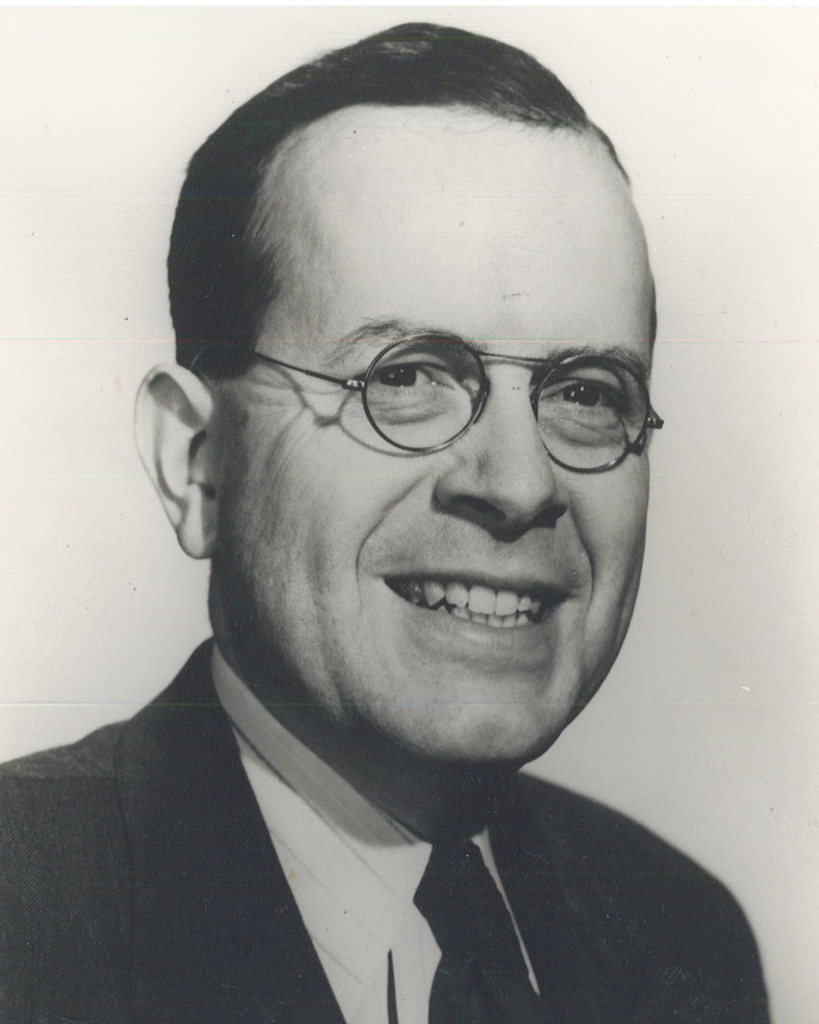
Derry’s pastor, Reverend William Longbrake, who had been called to Derry Church in 1941, helped Derry transition from wartime to peace. During his tenure membership grew from 312 to 533 members.
As membership increased, Derry Church sought to broaden church leadership. In 1947 Session voted to recommend to the congregation that a “Rotary System” be instituted for the election of officers. Traditionally, Elders had been elected by the congregation for three years and could be re-elected immediately to succeed themselves when their terms expired. Under the Rotary System, Elders would not be eligible for re-election for at least one year after serving a full term. This expansion of church leaders continued during the 1950s. In 1957 Derry elected its first women to serve as Deacons. However, it wouldn’t be until 1970 that Derry would elect its first female Elder.
As the United States emerged from World War II, the church began planning to expand the building to meet the needs of a rapidly growing congregation. In 1946 a building committee began assembling a list of wants and needs for a new building. Initially, Derry member Maurice Glace, a draftsman with Hershey Lumber Company, was asked to draw up plans. These plans were reviewed and revised over the next two years, but no final design was approved.
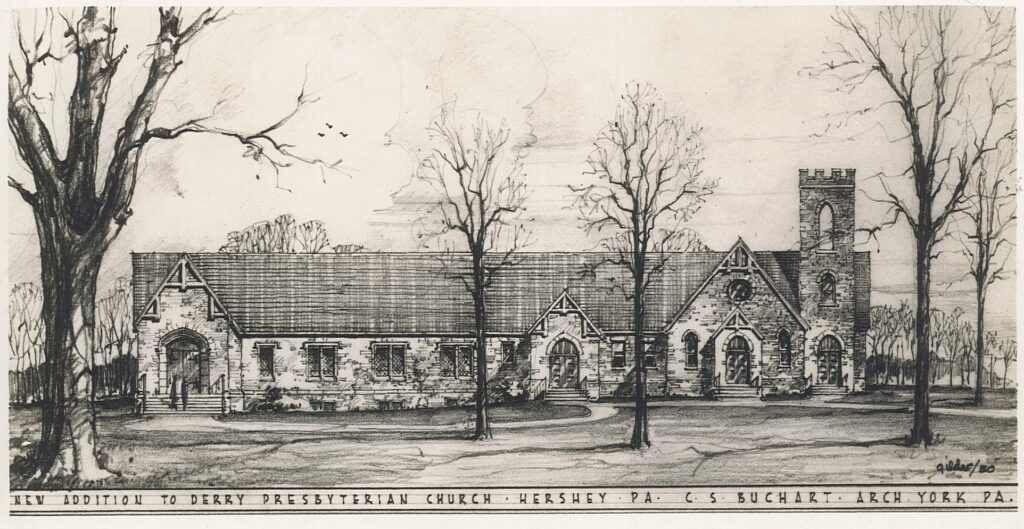
In 1948, the committee decided that a professional church architect was needed. Derry Church selected C.S. Buchart, a York, Pennsylvania architect, to design an addition to the Chapel. Mr. Buchart designed an addition that matched the original chapel in materials and architectural style while providing a modern plant for educational and social activities. In addition to plans for the Christian Education addition, Mr. Buchart also sketched out a vision to expand the church in the future with a new, larger sanctuary, if the congregation continued to grow at its current rate.
At a 1950 congregational meeting, members voted to approve plans to add a Christian education wing to the Chapel. Derry broke ground for the addition on October 29, 1950, and the cornerstone was laid on April 22, 1951. The building was dedicated seven months later, on November 11. This was the second addition to the 1884 Chapel, the first being the John Elder Memorial Chapel in 1935. The addition created a new entrance and foyer, and added a nursery and children’s classroom, as well as office space on the main floor. The new lower level had a large social hall and a modern kitchen. The addition made it possible for the church Sunday School to continue to expand with additional classes and provided space for the church to gather together in fellowship.
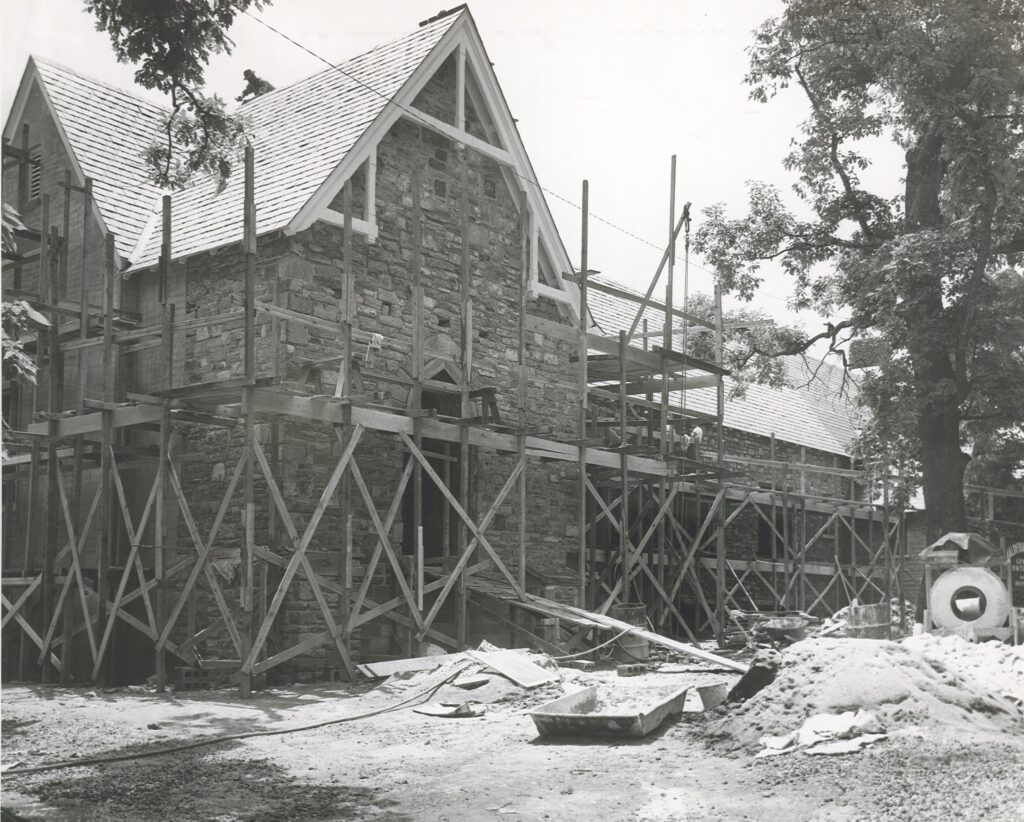
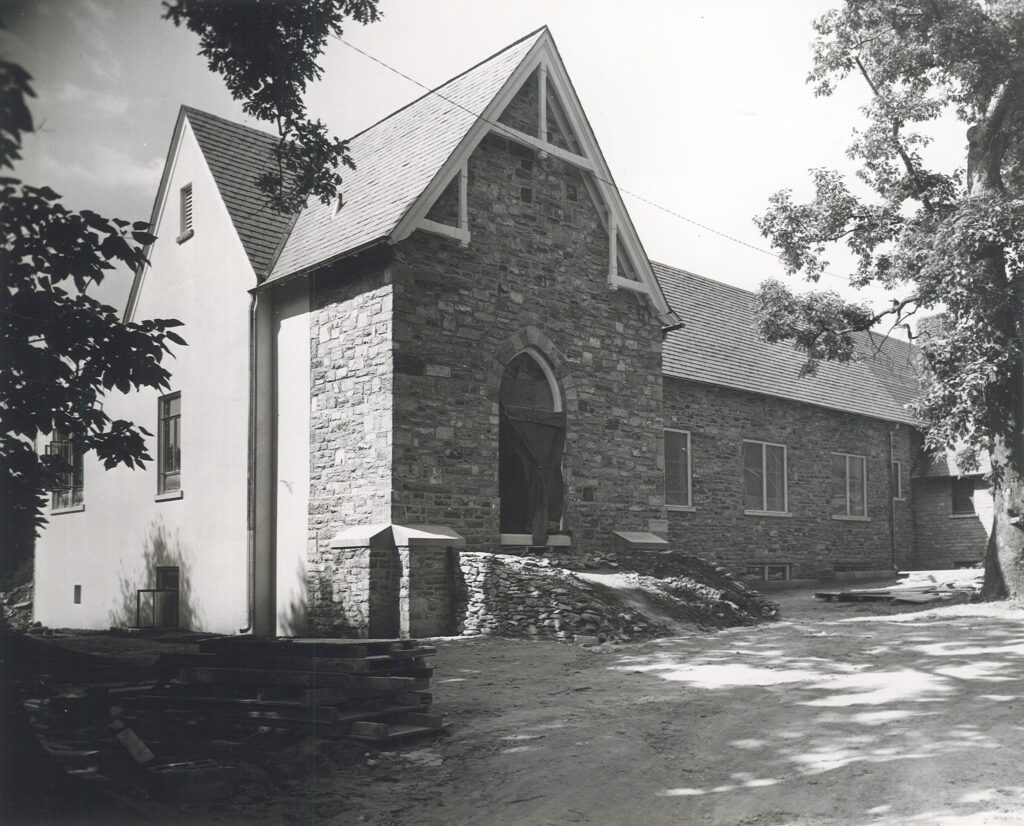
In 1950 Reverend Longbrake resigned to take another call. He was succeeded by Reverend William Sheldon Blair, who was installed on October 12, 1950. The congregation approved an annual salary of $3,800 plus a contribution to his pension, use of the manse, a car allowance of $400, a one-month vacation, and moving expenses.
Reverend Blair knew when he accepted the call to Derry Church that a building program to add an Educational Building was planned and that a Building Committee was already in place. During his first years he led the congregation to raise money for the new educational building with a variety of creative activities. Of course, there were congregational pledges, but at that time Hershey Park Pennsylvania Dutch Days had been recently launched (1949) and quickly became a popular week-long summer event.
Dutch Days created an opportunity for community organizations to support this event. The Dutch Days venue offered limited opportunities for visitors to purchase snacks and meals. Derry Church, located just a few blocks away from Dutch Days activities, offered meals for sale with a Pennsylvania German theme: chicken pot pie, ham and beans, roast beef and filling. The church also provided transportation between the church and Hershey Park to facilitate access. Other fundraising activities included a public Auction Sale in May, 1951 and the distribution of small wooden banks resembling a church (made by men on the Little Church Bank Committee) to children and adults in the congregation to encourage their participation.
The church’s efforts at fundraising were quite successful. On Thursday, February 2, 1956, just four and a half years after the building had been completed, a Recognition and Mortgage Burning Dinner was held in the new downstairs social room to celebrate the Church’s freedom from mortgage debt.
Derry Church had been built in pieces over the years beginning with the 1884 Chapel, which had been expanded in 1935. The need to replace worn carpeting and do general repairs to the older sections of the church became more obvious after the Christian Education Building was completed in 1951. Session authorized improvements to Derry Church in 1955, old carpeting was replaced, pews and floors were repaired and a much needed humidifier was also purchased.
The condition of the 1933 Chapel organ was such that Session members wondered if a new organ should be purchased or if that purchase should wait until when and if a new sanctuary was constructed.
The early 1950s saw the United States engage in a “cold war” with the Soviet Union and send its military to the Korean conflict. Carlisle Presbytery, concerned about the war, asked its churches to have a day of prayer for men behind the Iron Curtain.
At home, Hershey struggled with labor relations. In April 1953, Hershey Chocolate workers went out on strike over wages and a demand for a closed Union shop. Seeking to not take sides, at their May 1953 meeting Derry’s Session forbade Reverend Blair from attending any union meetings.
Reverend Blair resigned from Derry Church in January 1959 to accept another call to a church in Johnstown, Pennsylvania. While a search for his replacement was immediately started, Reverend George Evans served as Interim Pastor. In July Reverend Ira Reed was installed as Derry’s pastor.. The church continued to grow even though it was a time of conflict and division in our nation and the world.
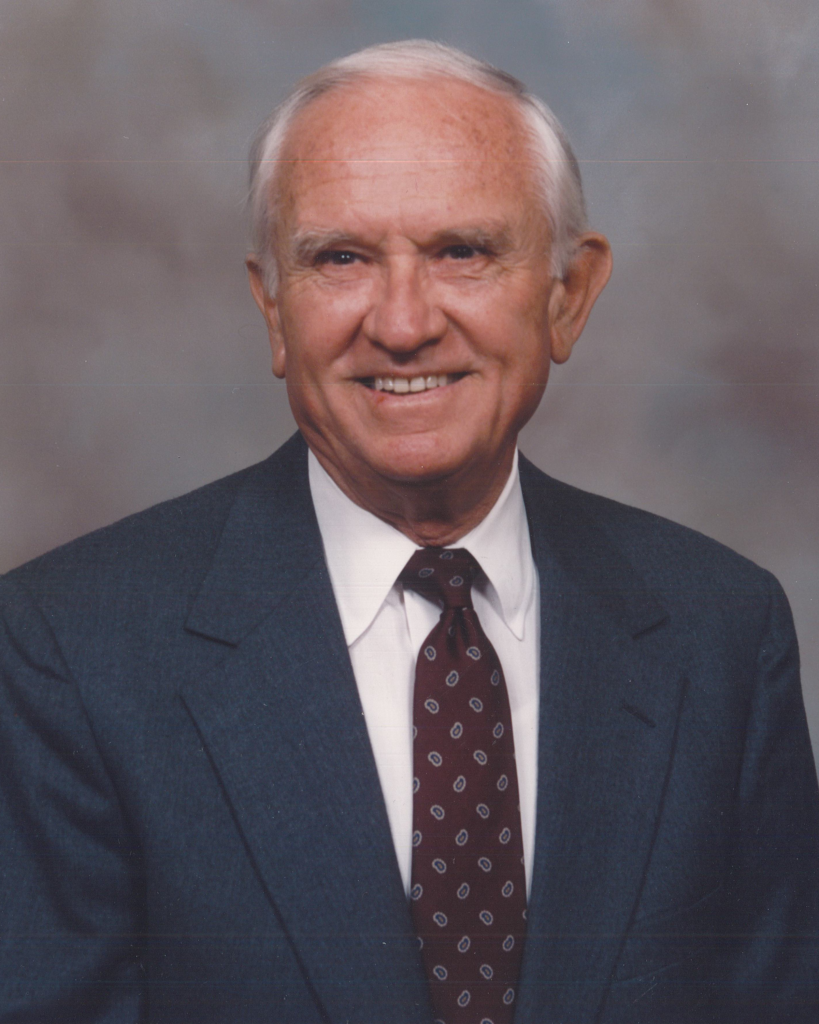
In addition to his excellent preaching, Reverend Reed is remembered for his organizational leadership and emphasis on neighborhood evangelism. He was actively involved in community organizations and was a member of the Hershey Rotary Club, the Police Advisory Board of Derry Township, and a Trustee of Wilson College (Chambersburg, PA). In addition, he was a PIAA official for wrestling and football.
Under Reverend Reed’s leadership, Session meetings became more organized, the number of elders, trustees and deacons was increased from eight to 12, and women became part of Derry’s leadership team. In addition, session committees were improved. The arrival of a new and energetic pastor again spurred expansion in Derry’s membership. By 1964 the church had grown to almost 800 members.
Though political assassination and social disruptions in the nation characterized much of the 1960s, Hershey and Derry Church were little affected. While there was awareness of national events, Derry Church’s concerns focused on the need for more space for Sunday school classrooms and a larger sanctuary to accommodate the growing congregation. In 1962 a building committee was appointed and by the end of 1964 a contract was signed to begin construction. Completed and dedicated in January 1966, the new Sanctuary included the purchase of a new organ. The Reuter organ was dedicated to the memory of a former pastor, Commander George Snavely Rentz, Chaplain, United States Navy. Commander Rentz served Derry 1913-16. He had left Derry in 1916 to serve as a Navy Chaplain during World War I. He continued to serve as Chaplain during World War II. He lost his life when the U.S.S. Houston was sunk during battle. Rentz was one of the last to leave the sinking ship and gave his life so other, younger, sailors might live.
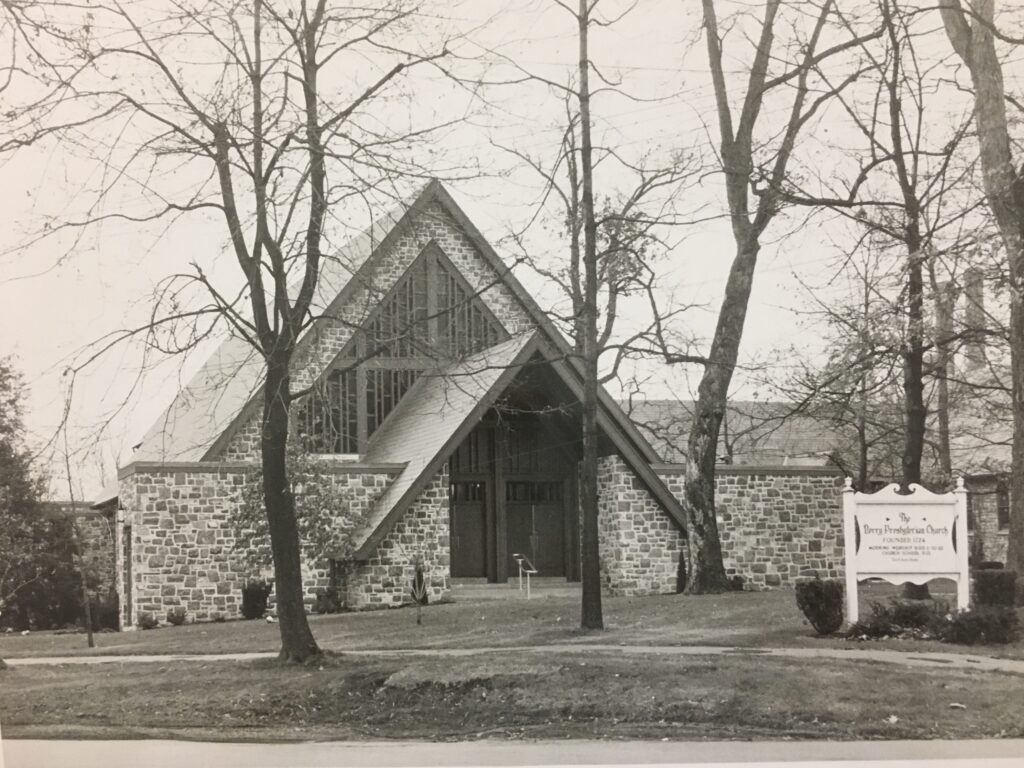
That same year the congregation approved the purchase of a property across the street for the purpose of expanding parking for the church.
Concurrent with plans to expand church facilities, the need for additional staff was becoming more urgent. Derry’s music program was growing and it was felt that a part-time organist was not sufficient for the church’s needs. In June 1963, the Music Committee recommended hiring an organist and a choir director. Richard Chubb was hired as organist and Virgil Anderson was hired as choir director.
After a review of Derry’s Sunday School by Carlisle Presbytery, it was recommended that Derry Church hire a part-time administrator. Derry member Harold Reichard volunteered to serve as the chair of the Christian Education program from September 1964 to September 1965. In his report to the Session, Reichard recommended that the position become full-time. In March, 1967 Reverend Robert Murphy was hired as Assistant Minister for Christian Education. Reverend Murphy served two years before resigning to accept another position. A second pastor, Reverend Paul O. Altaner, was hired, but he also resigned after not quite two years.
Finally, Derry Church created a new position, Director of Christian Education, and hired Nancy Joiner, a recent Grove City College graduate, to fill the position. At the same time Derry Church created a full-time Director of Music position and hired Herb Fowler. Both people brought new energy, ideas, and opportunities for music, youth engagement, and Christian education.